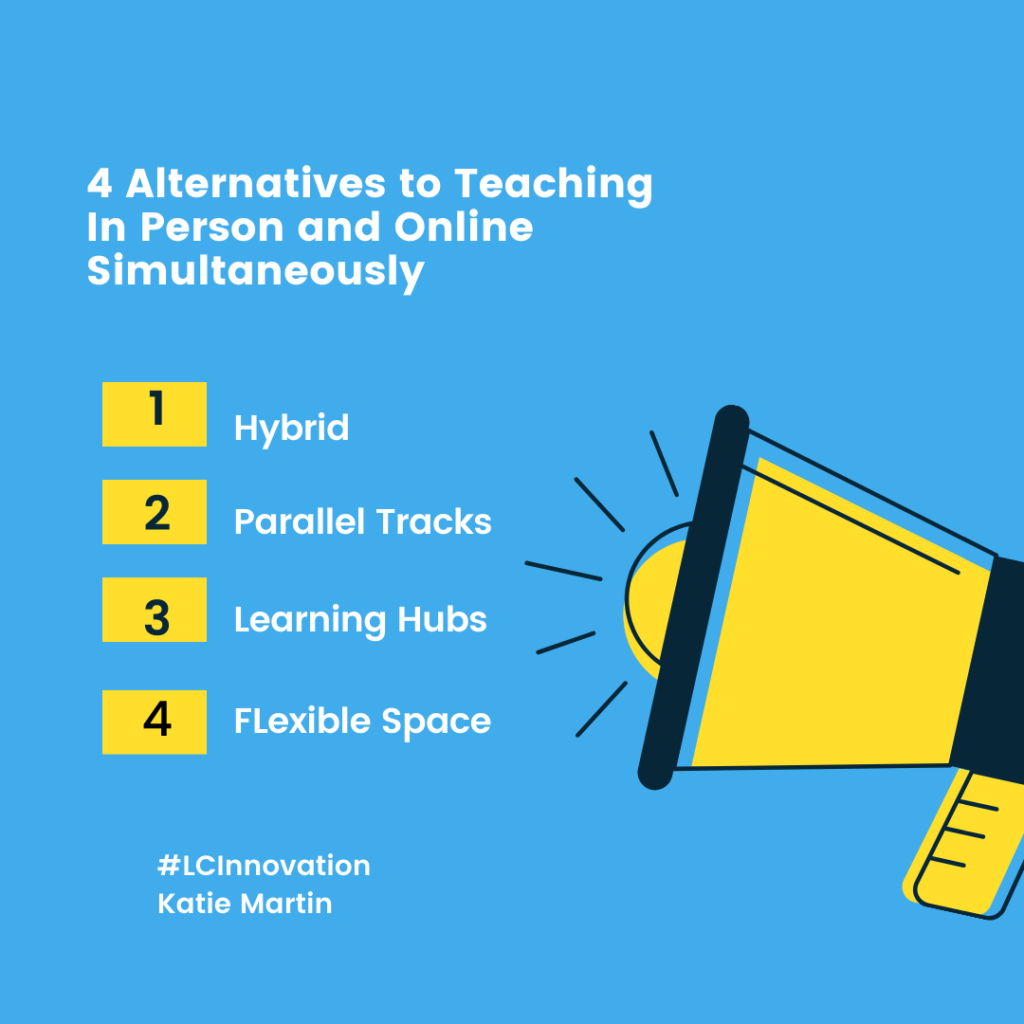Whether it’s in one-on-one conversations, facilitating meetings with leaders, reading blogs and Instagram posts, we see all over the country that teachers, school and district leaders, parents, and kids are burnt out, and struggling to cope. We are teaching, learning, and living in the middle of crises and we cannot (nor should we try in my opinion) keep up with the way it has always been, while things are far from normal. We can’t keep adding more to people’s plates without getting diminishing returns on our health, learning, and relationships.
One of the challenges that many educators are facing is that they are being asked to teach double duty; teaching students simultaneously in person and online in what some are calling “hybrid” models. This article This Isn’t What We Meant by Hybrid Learning highlights what hybrid actually means despite how many have implemented it.
I thought hybrid meant that students learn both online and in person, not that the teacher will teach students online and in person at the same time every day.
When I shared this article on Twitter, unsurprisingly I received many comments about the struggle to teach students who are in-person and remote at the same time. The needs of learners in person and online are inherently different and require a different approach. Teaching both often results in a lower quality experience for both students in-person and students who are remote, as it is virtually impossible for even the most skilled teachers to plan and manage both simultaneously. To be clear, this is not at the fault of the teachers, this is the fault of the design and the amount of work and effort that teachers are putting to meet their students needs is not surprising but also not sustainable.
I know there are many trying to make it work but I wonder at what cost. Finding alternatives that are sustainable for educators is critical as this article highlights that Pandemic Pain in Our Middle Schoolers: The Other Epidemic We Need to Talk About “We know 1 in 3 adults are reporting anxiety, and that’s significant because research shows emotions are contagious. Our students are not going to do as well when you consider very few adults are at their peak right now.”
I have been in search of bright spots and working with school leaders on designing and elevating other models that are more sustainable and likely to have a better impact on learners and learning, as well as our mental health. Here are some highlights.
4 Alternatives to Teaching Online and In-Person At the Same Time

(Actual) Hybrid
As many have pointed out, teaching both online and in person at the same time is not hybrid. A hybrid car does not use gas and electricity at the same time, you use one at a time depending on your needs and resources. Distinctly different from what some refer to as “hybrid”, are actual models that differentiate when students are in person with the teacher and when they are learning asynchronously, and what they will be using to leverage learning resources.
Poway Unified is providing AM and PM cohorts where students can go to school in small classes to allow for safety precautions and social distancing. The in person time is focused on literacy and math with targeted instruction and feedback. The at home hours are asynchronous practice using curriculum that is adaptive based on student’s skill level and choice boards that include STEM and arts activities. See a sample schedule here
Parallel Tracks
Menlo Park City School District has created parallel tracks to provide specific teachers and family choice and design effective learning models for each option.
Track 1- Hybrid:
The district created a hybrid model where students are attending one week in school and one week remote. Designated virtual teachers and district level personnel are managing the at home portion of learning with specialty classes and personalized playlists for students so the in person teachers can focus on their students who are in class.
Track 2- Remote Only Option:
Parallel to the hybrid, the district created a fully online, remote model also known as MPCSD Virtual Academy. They describe it as “An alternate plan for returning to school that families may select…This plan provides a fully at-home learning experience for families who do not want their children to attend in-person school.” These students have dedicated teachers who plan, design and engage with learners in a virtual setting. “The plan will be available for the entire 2020-21 school year, and may be enrolled into or out of each trimester dependent on space available at the time.”
For more information, you can access their plan here.
Learning Hubs
Some schools and districts where it may not be safe to reopen remain completely virtual but there is an effort to provide support and community for some students who need it.
For example, Alpine Unified created the space on school grounds to provide support and community for those in need. “Students are separated by plexiglass dividers. A substitute teacher is on hand to guide them through the process. Parents in the pods take shifts supervising the kids, making sure they get breaks outside.”
San Francisco Unified has partnered with SF Recreation and Parks Department, in partnership with community-based agencies and other City departments, have implemented the Community Hub Initiative, a Citywide, neighborhood-based strategy to support children, youth, and families during the school year. https://www.dcyf.org/care
Use Outdoor and Flexible Spaces:
Crest Elementary in Cajon Valley Unified School District (who has been providing a variety of in person and virtual supports) has created a pilot program for an outdoor school. This article highlights how over the summer students went on nine excursions and though explorations students learned about how waves worked and then got to actually play in the waves. “As the water pushed and pulled on them, one of them exclaimed that they “got” it for the first time. Parents of kids who struggle with academics spoke out about how it could help their kids enjoy school for the very first time.” Crest Elementary, a rural school has been shrinking over the past 17 years and now with the new offering, they have a waiting list of 60 families.
Transcend Education has also categorized new models and resources that are worth reviewing to see other variations and examples.
Regardless of the model you choose (or is chosen for you), here are a few things to consider:
How might you leverage the strengths of team members and create the conditions for teachers to collaborate rather than everyone having to do it all?
This is a great opportunity to move out of the typical silos to create teams of teachers to build on people’s strengths and lighten the enormous load. Some thrive with tech stuff, some the lesson design, others the feedback and guidance. Many teachers who are able to manage are in districts that are providing daily or weekly time for teachers to learn and collaborate. Eric Sheninget has some great strategies here.
How might you leverage community resources to support?
Schools have utilized volunteers and family members to support them in person for years. Consider how you could use community support and resources to support small groups to be more effective either in person or virtually. Overall, it seems as if we need less whole group synchronous and more small groups, 1:1, and independent/ asynchronous opportunities for learning. Consider how you could leverage college students, volunteers who want to contribute some time, student teachers, aides, and families to support small groups, teach lessons based on their passions and interests and relieve teachers from double duty if you can’t manage it with current staff.
How can you prioritize what matters most?
Less assigning, more learning. This was a suggestion from student feedback and can help prioritize what matters most or otherwise known as Marie Kondo the curriculum and “ identify key topics that “spark joy,” particularly topics that can enable teachers to hit upon multiple learning goals at once.” Consider how you might ask more questions, take time to ponder, research, investigate. and learn deeply, rather than trying to cram it all in.
Kind words, appreciation and support are important for all of us right now but as one teacher pointed out we need to stop telling teachers to take a break and focus on their well-being, we need to provide working conditions that make that possible. If you have models that are working to make teaching, learning, and living in a pandemic more manageable, please share them! I would love to learn and elevate what is working.



Hello,
Each district has to decide what models work best for their local circumstances(Budgets, state health requirements) in providing safe, equitable learning that is flexible and adaptable if classroom learning models must change if building or district wide quarantines are required. I would think every educator wants to interact with their students everyday which would be the most equitable approach. The pure hybrid models seldom if ever offer that. Students doing personalized playlists- Is that real time interactions with their teacher?
Teaching in person and remote students at the same time has been around for decades under the title of distance learning. Teachers have developed instructional models that have allowed this model to be very effective. In rural schools that depend on DL to provide their students access to courses their school cannot offer this dynamic approach can be used as a model for this “new not new” learning approach.
The learning model(s) a local district chooses will only succeed if combined with time to plan, train, and most vital; colleague to colleague support via team PLCs.